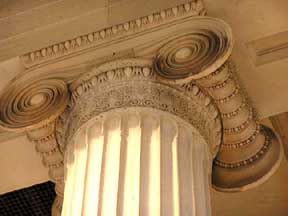Illustrated Architecture Dictionary ....................... Illustrated FURNITURE Glossary .
![]()
Illustrated Architecture Dictionary
.......................
Illustrated FURNITURE Glossary
.
Baluster
BAL a stir
Also called banister
|
|
 |
Architecture
1. A turned or rectangular upright supporting a railing or handrail, a series of such being called a balustrade2. The roll forming the side of an Ionic capital. Also known as a pulvinus.
Balustrade (BAL a strade): A railing with supporting balusters
Balusters may be straight, turned or pierced.
Vase-shaped/vasiform balusters (as in left illustration above) were introduced about 1650. The narrow section is referred to as the "sleeve," while the wider section is the "belly."
The balustrade is undoubtedly a Renaissance, especially 14th century Florence, invention. (The Romans used lattice motifs.)
Cast-stone balusters were a development of the eighteenth century in Great Britain; cast iron balusters a development largely of the 1840s.
... double or symmetrical baluster, which means it has vertical symmetry with its bulbous sections stacked vertically ...
The more familiar Renaissance baluster form is the single baluster or a baluster with only one swollen section or belly, lending it a bulbous vase form. Like the double baluster, scholars generally agree that the single baluster form was inspired by Roman candlesticks ... It is this shape that gives us the name for the type.
The word baluster is derived from the Italian word balaustro, which is the term for the flower bud of the pomegranate tree.
- Calder Loth, Classical Comments: Balusters (Online June 2019)
Wittkower distinguished two types, one symmetrical in profile that inverted one bulbous vase-shape over another, separating them with a cushionlike torus or a concave ring, and the other a simple vase shape ...
The baluster, being a turned structure, tends to follow design precedents that were set in woodworking and ceramic practices, where the turner's lathe and the potter's wheel are ancient tools. The profile a baluster takes is often diagnostic of a particular style of architecture or furniture, and may offer a rough guide to date of a design, though not of a particular example.
- Wikipedia: Turning (Online April 2016)Roof-top or roof-line balustrades are found in Neoclassical, , ..... Colonial Revival, , ..... Federal, , ..... Georgian Revival, , ..... Beaux Arts Classical,, ..... Italian Renaissance Revival styles
Found in derivatives of Classical Greek and Roman architecture - but not in Greek or Roman architecture - including Beaux Arts Classicism, , ..... Federal, , ..... Georgian Revival, , ..... Greek Revival, , ..... Neoclassicism, , ..... Renaissance Revival, , ..... Second Empire
See also: American staircases
FurnitureUsed as a stretcher between chair legs, or part of a chair back.
Commonly an elongated urn or vase shape.
Applied split or half balusters used as ornamentation and in a vertical series on a chair back
"... baluster forms are familiar in the legs of chairs and tables represented in Roman bas-reliefs, where the original legs or the models for cast bronze ones were shaped on the lathe, or in Antique marble candelabra, formed as a series of stacked bulbous and disc-shaped elements, both kinds of sources familiar to Quattrocento designers." - Wikipedia: Baluster
Definition #1 series of balusters - examples from Buffalo:
- Left illustration above: Knox House (Definition #1 series of balusters)
- Lowry House, Midway (Definition #1 series of balusters)
- Stephen M. Clement House/Red Cross (Definition #1 series of balusters)
- Forest Lawn Triple-Arch Bridge (Definition #1 series of balusters)
- 165 Chapin Pkwy (Definition #1 series of balusters)
- Guaranty Building (Definition #1 series of balusters)
- Ansley Wilcox Mansion / Theodore Roosevelt Inaugural Site (Definition #1 series of balusters)
- 800 West Ferry (Definition #1 series of balusters)
- Dr. Charles Cary House, 340 Delaware Ave. (Definition #1 series of balusters)
- Gothic City Architectural Antiques (Definition #1 series of balusters)
- Bemis House (Interior) (Definition #1 series of balusters)
- Eberhardt House (Interior) (Definition #1 series of balusters)
- Buffalo Savings Bank / M& T Bank (Interior) (Definition #1 series of balusters)
- Dr. Charles Cary House, 340 Delaware Ave. (Interior) (Definition #1 series of balusters)
- Private club in Buffalo (Georgian Revival interior) (Definition #1 series of balusters)
- Electric Tower (Art Deco stainless steel) (Definition #1 series of balusters)
- Eastlake - 51 Symphony Circle (Definition #1 series of balusters)
- First Baptist Church / 14 North (Definition #2 - Baluster roll)
Definition #2 examples from Buffalo:
- Right illustration above: Albright-Knox Art Gallery (Definition #2)
- Silverthorne House (Definition #2)
Furniture Examples from Buffalo:
- Furniture: Court ("short") cupboard - Knox House / Blessed Sacrament RC Church Parish Office
- Furniture: Pedestal table - Edward Harvey House. 91 Jewett Parkway
Other Examples, not in Buffalo:
- Definition #1 series of balusters - Siena Cathedral, Italy
- Definition #1 series of balusters - Drayton Hall near Charleston, S.C.
- Definition #1 series of balusters - University of Virginia, Charlottesville, Virginia
- Definition #1 series of balusters - Carpenters' Hall, Philadelphia, Pa.
- Definition #1 series of balusters - Holiday Inn, Pompano, Florida
- Definition #1 series of balusters - Hotel de Villes (City Hall), Nyon, Switzerland - Example #1
- Definition #1 series of balusters - Hotel de Villes (City Hall), Nyon, Switzerland - Example #2
- Definition #1 series of balusters - Opéra National de Paris Baroque style
- Definition #1 series of balusters - Charles University, Prague, Czech Republic Baroque style
- Definition #1 series of balusters - St. Nicholas Church, Lesser Town Square (Little Quarter Square), Prague, Czech Republic Baroque style
- Definition #1 series of balusters - Oshevnev House, Kizhi, Russia Russian vernacular style
- Definition #1 series of balusters - Forbidden City, Beijing
- Definition #1 series of balusters - Palazzo Chiericati, Vicenza Double balusters
- Definition #2 Erectheion, Acropolis, Athens, Greece
- Definition #2 Wawel Castle Cracow (Krakow), Poland
